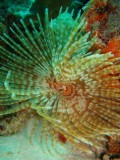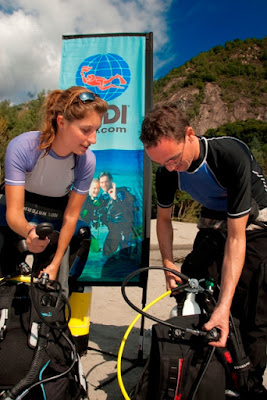Emily Post’s Boat Diving Etiquette
Most experienced divers have been on a boat where the
practices of naïve or less experienced divers detracted from the overall
experience. While many of the topics I am going discuss would help alleviate
some of this discomfort, I am really
trying to project safe and practical concepts that will help prevent personal
disappointments and safety concerns for all boat divers. In this blog I will
suggest some standard boat diving procedures that will enhance your experience.
The two most important times on a boat are the briefings. A
good crew will give you a safety briefing on the boats equipment itself and the
dive. Good safety briefings are often entertaining. They should contain
information on how to use the important safety equipment and what will be
expected of you in common boating emergencies. The dive briefing will cover entry
and exit procedures as well the depth, bottom time, underwater communication
and hand signals, as well as points of interest and maybe a history of the
site. Often times, passengers don’t pay attention to these briefings just like
they tune them out on an airliner or worse yet talk through them preventing
others from paying attention. Unlike an airliner almost all boats are different
and have different procedures. The worst diving injuries occur when getting off
the boat or getting back on the boat. I recently read an article in an Alert
Diver magazine about a divemaster. Even
though this was not his boat and he was on vacation he felt that being a
divermaster meant those silly rules in the briefing didn’t apply to him. When
it came his time to exit the water he held onto the swim platform to remove his
fins. (This was not the procedure that was briefed.) The stern went up with a
wave. He was sucked under the swim platform. When the boat came back down it
crashed into his ribs breaking 2 of them and ended his vacation. Before you
stand up to get in the water make sure you are ready. Your mask on your face
and your regulator in your mouth. Don’t
stand up until the crew is ready for you. It is too easy to fall over and knock
out your dive buddy or fall off the back of the boat while making last minute
adjustments. When you surface inflate your BCD then while reboarding a boat
keep your regulator in your mouth and your mask on your face from the time you
surface until you are sitting down. First you won’t drown and second, you are
protected should you fall back into the water. LISTEN to the briefings. The
crew who works the boat everyday knows better than anyone else how to have a
safe and enjoyable experience on it.
While I have concluded my stand on briefings, I would like
to emphasize what you should do if one is not presented or inadequate. You
should know where the first aid equipment, oxygen, and the fire fighting
equipment is. You should also ask about the radio. Remember channel 16 is the international hailing and
distress channel. If the Captain and crew don’t want to provide you with
adequate answers to these questions you should rethink your choice about
boarding the boat.
Before you board a boat always ask permission from a crew
member. Although they usually appreciate your willingness to move things along,
you may be in the way of them completing important preparations. I am really
thankful when divers offer to help. However, don’t be embarrassed if the crew
declines. Especially when boating maneuvers are involved. The crew usually has its
own way of doing things very efficiently and a helper, more often than not, throws
a monkey wrench in a well oiled machine. If you have ever watched Riann or I do
our ballet dance around the boat when we depart or return you will know what I
am talking about. Furthermore, there may be a safety or liability issue
involved that you are unaware of.
Last but not least, bring only what you need. Make sure your
equipment is well marked. Do you know how many manufacturers make black BCD’s…
ALL OF THEM. You don’t have to prove you are a great diver by bringing every
piece of equipment you own. More often than not it gets spread out all over the
deck and misplaced. I had a customer who spent his whole dive mad at his son
for losing a $1000 dive computer and failed to enjoy his experience. Oh wait,
did I forget to mention this guy chewed me out because I suggested he leave his
technical equipment at home only to watch him unpack 2/3 of it on the boat?
While he was diving I found it under a pile of his unneeded equipment. I’m not
talking about things like sunglasses, cell phones, and sun tan lotion. Some of
these are necessary for important reasons. Ask a crew member where you should
put them to keep them dry and safe. My cell phone is always in the driest place
on the boat. Neither sunglasses nor masks belong in a weight box. I should add
up the cumulative value of such items I find in a weight box in 1 month. I’ll bet it’s in the thousands of dollars.
WEIGHTS BREAK THINGS. They don’t belong where tanks are going to go either. Don’t
leave sunglasses hanging from a bungy or a mask sitting on a bench or tank
well. I like to attach my mask to the chest strap of my BCD. That way I know no
one will sit on it or crush it with a tank. I never have trouble finding it
when I am ready to get back in the water either. A weight left on a bench means
a blackened toe nail. Keep all weights on the deck so they don’t wind up on
your foot. Spray on sun tan lotions make a boat deck SLIPPERY. Put it on before
you board the boat.
Camera buckets are for cameras. The most common reason for a
camera to leak is a giant stride entry. The second most common cause is the
improper use of a camera bucket. Camera owners, for the most part, are careful
about placing not throwing their cameras in. Defogging agents can be very harsh
on o-rings and gaskets. Make sure the bucket you are putting your mask into is
not exclusively a camera bucket.
Be a courteous boat diver. Listen to the briefings. Be aware
of your equipment and try not to invade the space of others. Follow common
sense boat diving procedures and you will have a much more pleasurable boat
diving experience.
Until next time always make your total number of ascents
equal your total number of descents.
Your really cool blogger,
Duane








































